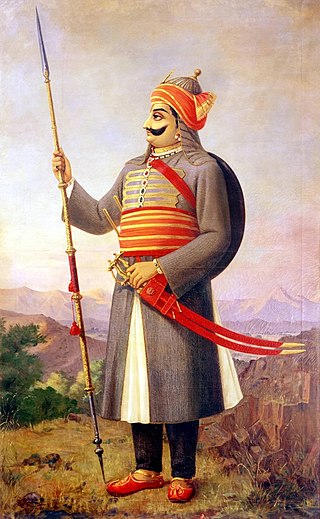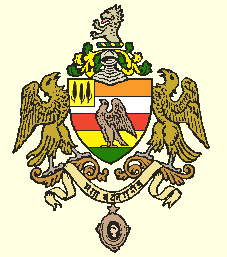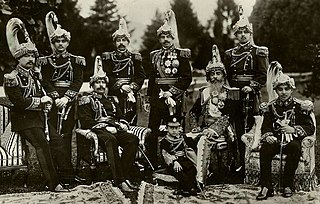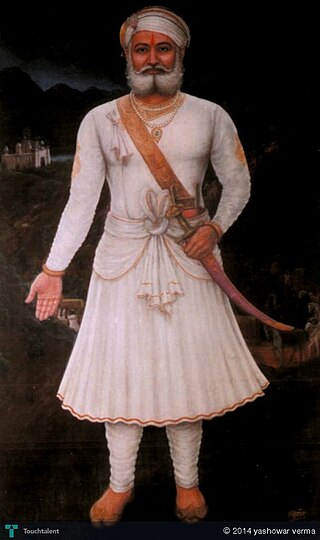Related Research Articles

Pratap Singh I, popularly known as Maharana Pratap, was a king of Kingdom of Mewar, in north-western India in the present-day state of Rajasthan. He is notable for leading the Rajput resistance against the expansionist policy of the Mughal Emperor Akbar including the Battle of Haldighati.

The Sisodia is an Indian Rajput dynasty belonging to the clan that ruled over the Kingdom of Mewar, in the region of Mewar in Rajasthan. The name of the clan is also transliterated as Sesodia, Shishodia, Sishodia, Shishodya, Sisodya, Sisodiya, Sisodia.

The Rathore dynasty or Rathor dynasty was an Indian dynasty belonging to the Rathore clan of Rajputs that has historically ruled over parts of Rajasthan, Gujarat and Madhya Pradesh.
Maharana Hammir Singh (1302–1364), or Hammir, was a 14th-century ruler of Mewar in present-day Rajasthan, India. Hammir Singh, was a scion of the cadet branch Rana of the Guhila dynasty, who regained control of the region, re-established the dynasty after defeating the Tughlaq dynasty, and captured present-day Rajasthan from Muslim forces of Delhi and became the first of the 'Rana' branch to become the King of Mewar with title of Maharana. Hammir also became the progenitor of the Sisodia clan, a branch of the Guhila dynasty, to which every succeeding Maharana of Mewar has belonged.

Mandore is a suburb Historical town located 9 km north of Jodhpur city in Jodhpur district in the Indian state of Rajasthan.

The Rana dynasty were a Chhetri dynasty that imposed authoritarianism in the Kingdom of Nepal from 1846 until 1951, reducing the Shah monarch to a figurehead and making the Prime Minister and other government positions held by the Ranas hereditary. They are Kshatriya, whose ancestors were descended from the Ranas of Udaipur, Rajasthan, India. The Rana dynasty is historically known for their iron-fisted rule. This changed after the Revolution of 1951 with the promulgation of a new constitution, when power shifted back to the monarchy of King Tribhuvan.

Bhama Shah (1547–1600) was a noted general, minister and close aide of Maharana Pratap Singh. The financial support provided by him allowed Maharana Pratap to restore his army and reclaim much of his lost territory.

Sodhi is a Khatri clan from the Punjab region. Seven of the Sikh Gurus, from Guru Ram Das to Guru Gobind Singh were of Sodhi surname.

Kingdom of Marwar, also known as the Jodhpur State under the British, was a kingdom in the Marwar region from 1243 to 1818 and a princely state under British rule from 1818 to 1947. It was established in Pali by Rao Siha, possibly a migrant Gahadavala noble, in 1243. His successors continued to struggle against regional powers for domination and 9 out of 15 rulers till 1438 died in combat. In 1395, its capital was changed to Mandore by Rao Chunda of Mandore and to Jodhpur in 1459 by Rao Jodha.
Bhainsrorgarh Fort or Bhainsror Fort is an ancient fort that has become a major tourist spot in the state of Rajasthan, India.

The Nakai Misl, founded by Sandhu Jats, was one of the twelve Sikh Misls that later became the Sikh Empire. It held territory between the Ravi and Sutlej rivers southwest of Lahore in what became Pakistan. The misl fought against the Sials, the Pathans and the Kharals before it was incorporated into the Sikh Empire of the Sukerchakia Misl by Ranjit Singh.
Rao Nara, . Rao Nara was of Rathore lineage and the crown Prince of Nadol, the then small kingdom in northwest India in the 15th century. Nadol had been ruled by the Chauhans in the 11th to 14th centuries, but was taken over by the Rathores. His father was Rao Samra, the Raja (King) of Nadol. Rao Nara is significant in the history of India, as he plays a crucial role in the founding of Jodhpur, India in 1459 with Rao Jodha.
Rana Lakha was the Sisodia Rajput ruler of Mewar Kingdom .He was the son of Rana Kshetra Singh and ruled Mewar from 1382 until his death in 1421.

Rana Mokal or Mokal Singh, was the fourth ruler of Mewar Kingdom,the youngest son of Rana Lakha and father of Rana Kumbha of Mewar.
Rao Ranmal, also called Ran Mal or Ridmal, was the Rathore ruler of Marwar. A notable expansionist and skilled warrior, Ranmal is also noteworthy for having twice served as regent of the kingdom of Mewar under two different kings.
Hansa Bai was Rani of the Rajput kingdom of Mewar during the early 15th century. She was the wife of Maharana Lakha Singh and mother to his heir, Mokal.
Chunda was the eldest son of Maharana Lakha, the ruler of Mewar. He is known in history for his sacrifice of his rights to the throne, to keep his promise. He was the heir-apparent until he renounced his right in favour of the heir born from Hansa Bai, the Rathore princess who was married to Maharana Lakha.
Rao Chunda Rathore was the 12th ruler of Marwar. His reign saw the consolidation of Rathore rule in Marwar, through his diplomatic and military prowess.
Alhaji Barhath, or Alhaji Rohadia, was a Rajasthani poet, warrior & horse trader known for providing shelter to Rao Chunda of Mandore during his childhood, who is credited with laying the foundation of the Rathore rule in Marwar.
References
- ↑ Sreenivasan, Ramya (2006). "Drudges, Dancing Girls, Concubines: Female Slaves in Rajput Polity, 1500-1850". In Chatterjee, Indrani; Eaton, Richard M. (eds.). Slavery and South Asian History. Indiana University Press. p. 148. ISBN 978-0-25311-671-0.
- ↑ Bakshi, S.R.; Gajrani, S.; Singh, Hari (2005). Early Aryans to Swaraj. Vol. 3. New Delhi: Sarup & Sons. p. 444. ISBN 978-81-7625-537-0.